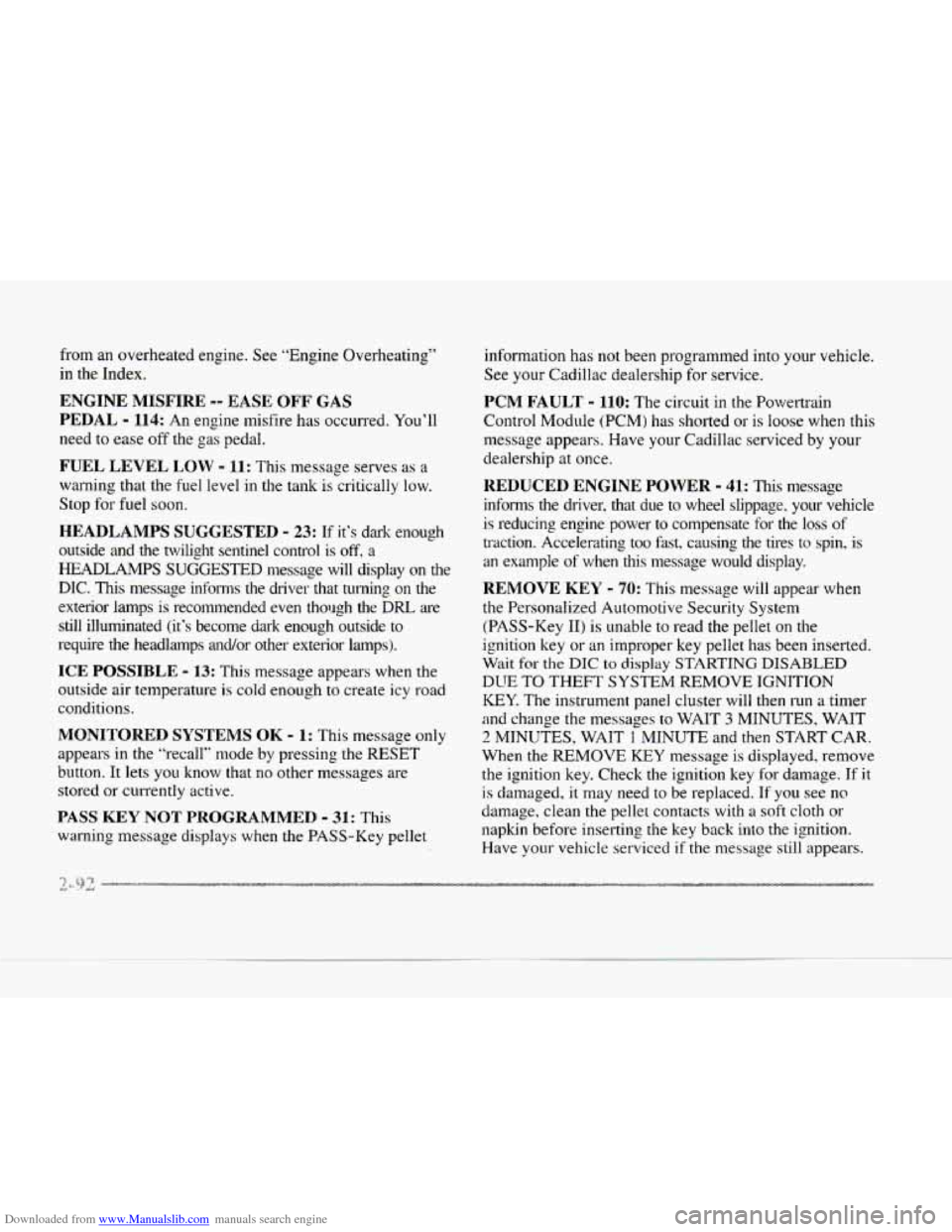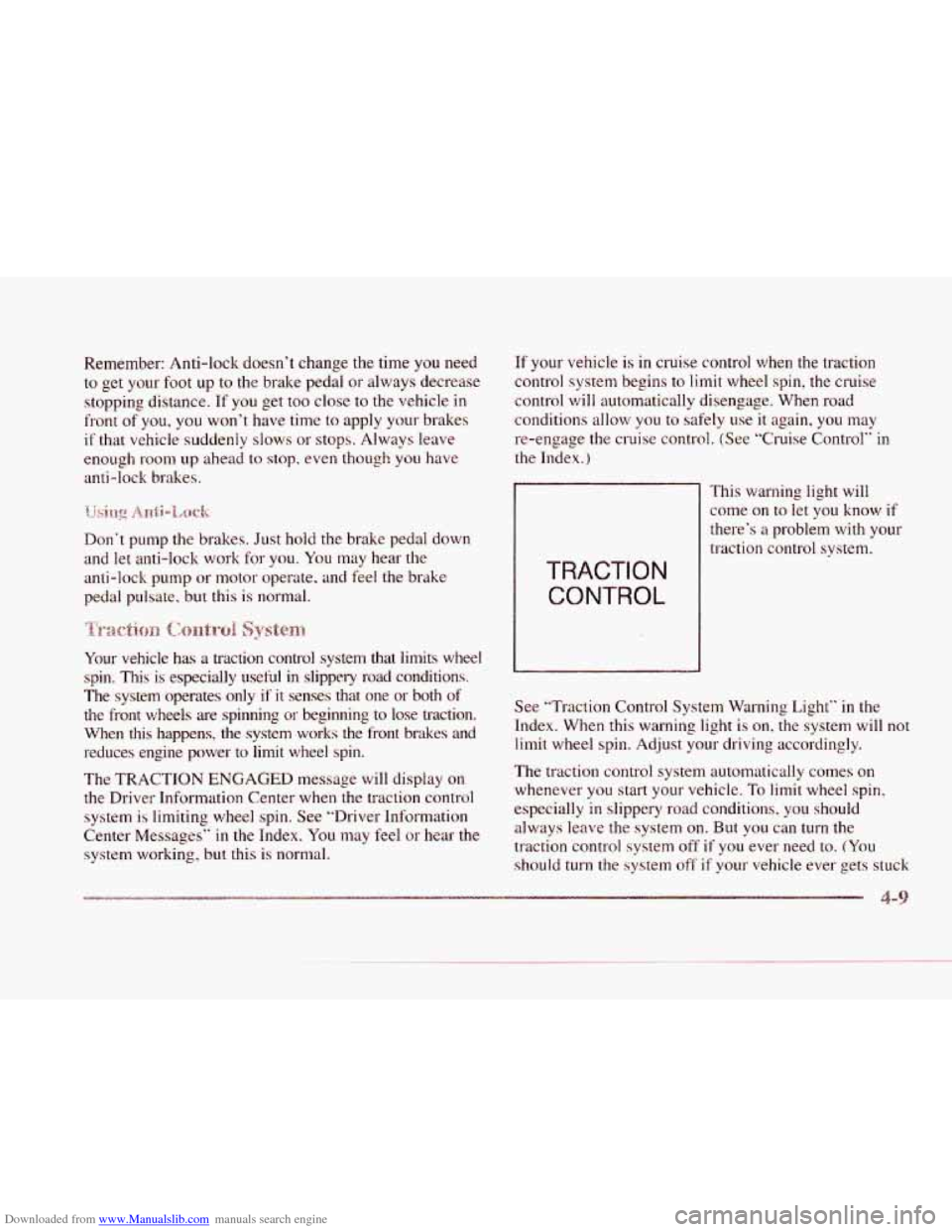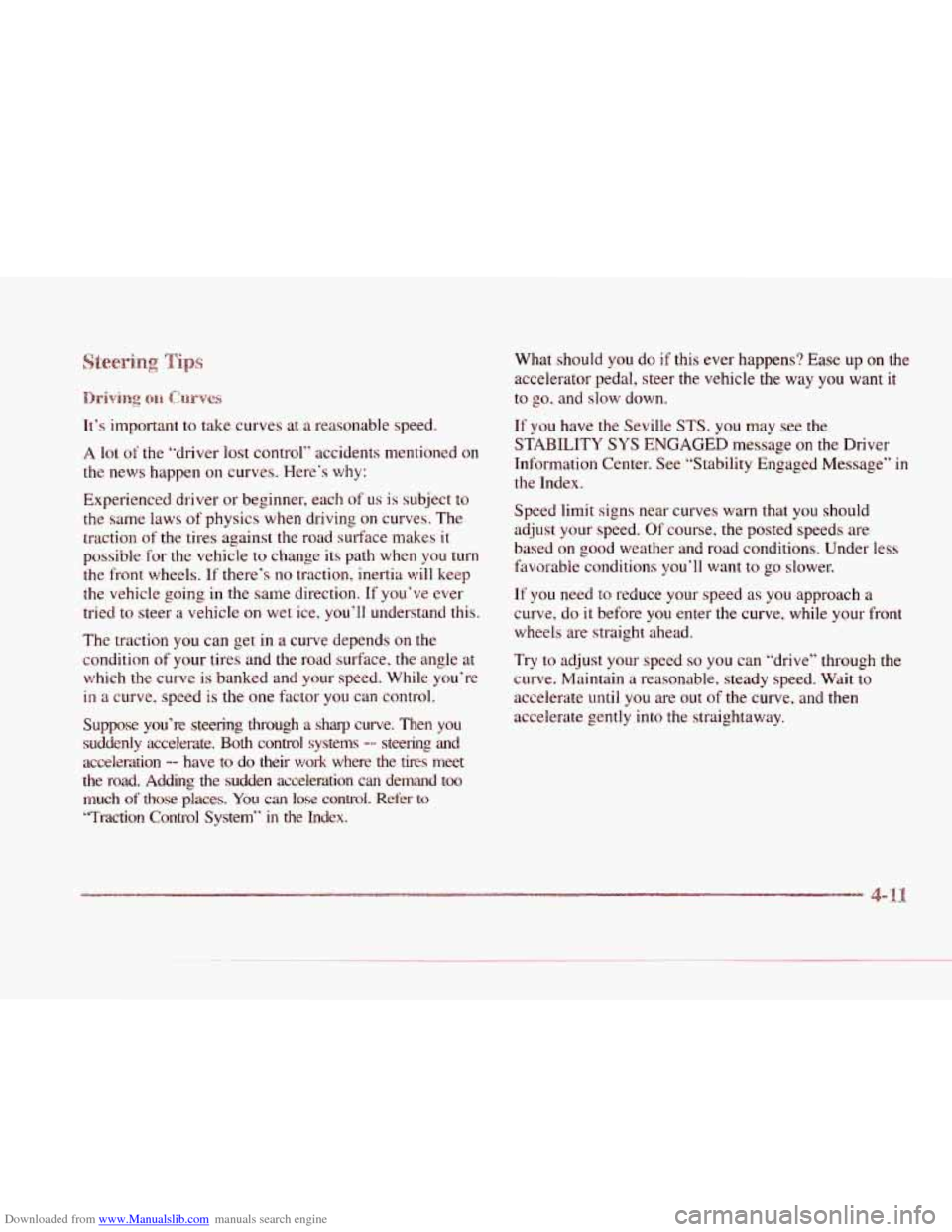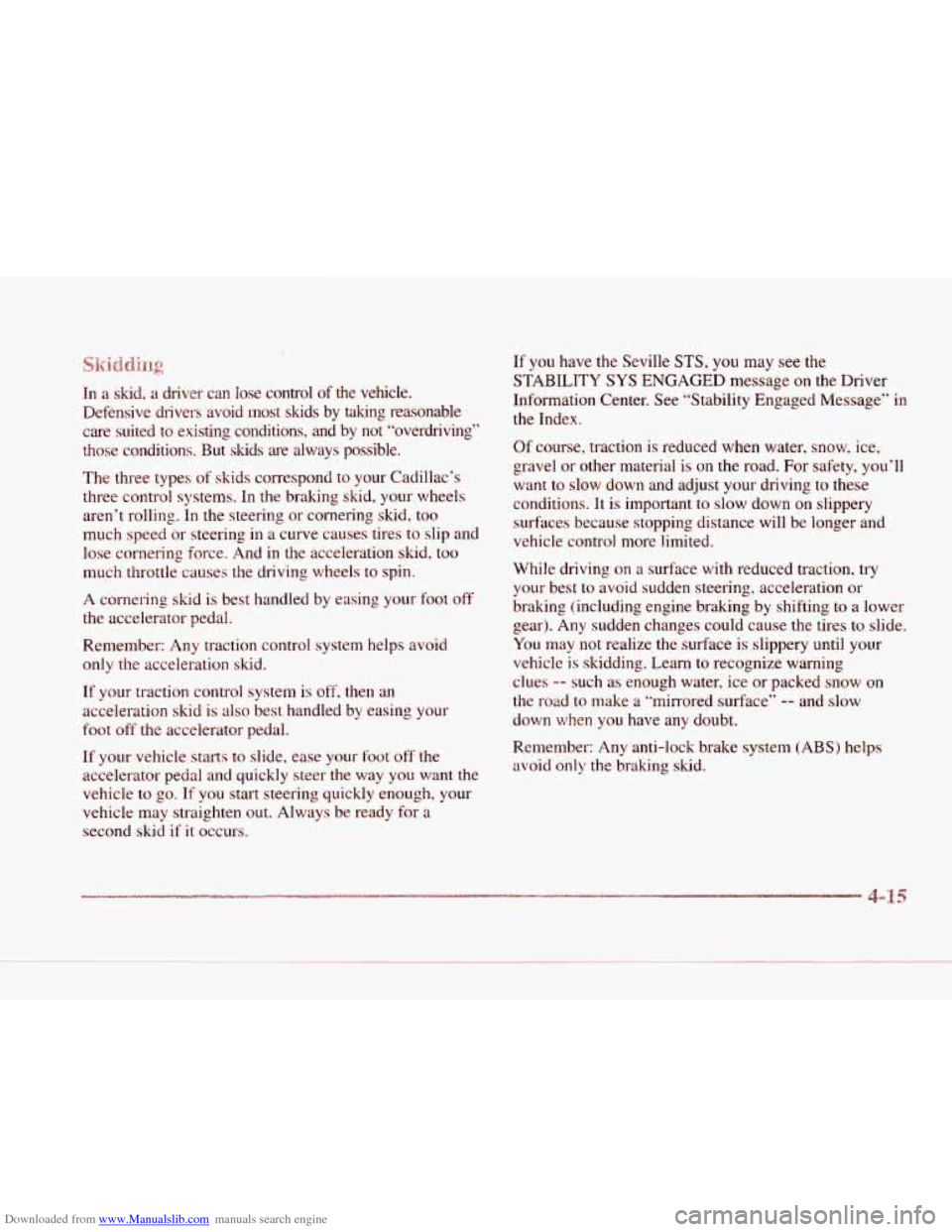1997 CADILLAC SEVILLE change wheel
[x] Cancel search: change wheelPage 102 of 370

Downloaded from www.Manualslib.com manuals search engine c
With cruise control, you can maintain a speed of about
25 mph (40 km/h) or more without keeping your foot on
the accelerator. This can help on long trips. Cruise
control does not work at speeds below about 25 tnph
(40 km/h).
Cruise control shuts off when
you apply your brakes
8 Cruise control can be dangerous where you
can’t drive safely at a steady speed.
So,
don’t use your cruise control on winding
roads or in heavy traffic.
slippery roads. On such roads, fast changes
in tire tractiom can cause needless wheel
spinning, and
you could lose control. Don’t
@ Cruise control can be dangerous on
If your vehicle is in cruise control when the traction
control system begins to limit wheel
spin, the cruise
control
will automatically disengage. (See “Traction
Control System”
in the Index.) When road conditions
allow
~CXI to safely use it again. you may turn the
cruise control
back on.
Page 153 of 370

Downloaded from www.Manualslib.com manuals search engine from an overheated engine. See ”Engine Overheating”
in the Index.
ENGINE MISFIRE -- EASE OFF GAS
PEDAL - 114: An engine misfire has occurred. You’ll
need to
ease off the gas pedal.
FUEL LEVEL LOW - 11: This message serves as a
waming that the fuel level in the tank is critically low.
Stop for fuel soon.
HEADLAMPS SUGGESTED - 23: If it’s dark enough
outside and the twilight sentinel control is
off, a
€EADLAMPS SUGGESTED message will display on the
DIC.
This message info~lns the driver that turning on the
exterior lamps
is recommended even though the DRL are
still illuminated (it’s become dark enough outside
to
require the headlamps andor other exterior lamps).
ICE POSSIBLE - 13: This message appears when the
outside air temperature is cold enough to create icy road
conditions.
&iONITORED SYSTEhIS OK - 1: This message only
appears in the “recall” mode by pressing the RESET
button.
It lets you know that no other messages are
stored
or cumently active.
PASS KEY NOT PROGRAMMED - 31: This
warning message displays when the PASS-Key pellet information
has not
been programmed into your vehicle.
See your Cadillac dealership for service.
PCM FAULT - 110: The circuit in the Powertrain
Control Module
(PCM) has shorted or is loose when this
message appears. Have your Cadillac serviced by your
dealership at once.
REDUCED ENGINE POWER - 41: This message
informs the driver, that due to wheel slippage, your vehicle
is reducing engine power to compensate for the loss of
traction. Accelerating too fast, causing the tires to spin, is
an example of when this message would display.
REMOVE KEY - 70: This message will appear when
the Personalized Automotive Security System
(PASS-Key
11) is unable to read the pellet on the
ignition key or an improper key pellet
has bee.n inserted.
Wait for
the DIC to display STARTING DISABLED
DUE TO THEFT SYSTEM REMOVE IGNITION
KEY. The instrument panel cluster will then run a timer
and change the messages to WAIT
3 MINUTES, WAIT
2 MINUTES, WAIT 1 MINUTE and then START CAR.
When the REMOVE
KEY message is displayed, remove
the ignition key. Check the ignition key
for damage. If it
is damaged, it may need to be replaced. If you see no
damage, clean the pellet contacts with a soft cloth or
napkin before inserting the key back into the ignition.
Have your vehicle serviced if
the message still appears.
c
Page 160 of 370

Downloaded from www.Manualslib.com manuals search engine c
c In this section, you'll find out how to operate the comfort control and audio systems offctd with our Cdiilac. Be
sure
to read about the particular systems supplied with your vehicle.
c
c
c
3-2
3-2
3 -6
3-7
3-7
3-7
3-9
3-9
3-10
3-10
3-10
3-
10
3-a
Comfort Controls
Climate Control Panel
Electronic
Solar Sensor
Air Conditioning
Heating
Ventilation System
Defrosting
Rear Window Defogger
HVAC Steering Wheel Controls
Climate Control Personalization
Audio Systems
Setting the
Clock
AM-FM Stereo with Cassette Tape Player and
Optional Compact Disc
Player
3- 17
3-2 1
3-25
3-25
3-25
3-26
3-26
3-27
3-28
3-28
3-14 Bose'" AM-Fh;? Stcrco v:ith C''l3hctte Tape
and Compact
Disc Play-
Boss T"' AM-FM Stereo with C'wctte
TT'ape and Compact Disc Pl;~yc.~- with Digital
Signal Processing
Trunk Mounted
CD Changer
Radio Personalization
Theft-Deterrent Feature
Audio Steering Wheel Controls
Understanding Radio Reception
Tips About Your Audio System
Care
of Your Cassette Tape Player
Care
of Your Compact Discs
Power Antenna Mast Care
c 3-:1
Page 199 of 370

Downloaded from www.Manualslib.com manuals search engine I The anti-lock system can change the brake pressure faster
Here’s how anti-lock works. Let’s say the road is wet.
You’re driving safely. Suddenly an animal jumps
out in
front
of you.
You slam
on the brakes. Here’s what happens with ABS.
A computer senses that wheels are slowing down. If one
of the wheels is about to stop rolling. the computer will
separately work the brakes at each front wheel and at the
rcar wheels.
U
You can steer around the obstacle while braking hard.
As you brake, your computer keeps receiving updates on
wheel speed and controls braking pressure accordingly.
Page 200 of 370

Downloaded from www.Manualslib.com manuals search engine c
c
c
L
Remember: Anti-lock doesn’t change the time you need
to get your foot up to the brake pedal
or always decrease
stopping distance.
If you get too close to the vehicle in
front of you, you won’t have time to apply your brakes
if that vehicle suddenly slows or stops. Always leave
enough room up ahead to stop. even though
you have
anti-lock brakes.
thg AnJ:i=f,.ciick
Don’t pump the brakes. Just hold the brake pedal down
and let anti-lock work for you.
You may hear the
anti-lock pump or motor operate. and feel the brake
pedal pulsate. but this is normal.
Your vehicle
has a traction control system that limits wheel
spin.
This is especially useful in slippely road conditions.
The system operates only
if it senses that one or both of
the front wheels are spinning or beginning to lose traction.
When
this happens, the system works the front brakes and
reduces engine power to limit wheel
spin.
The TRACTION ENGAGED message will display on
the Driver Information Center when the traction control
system is limiting wheel spin. See “Driver Information
Center Messages”
in the Index. You may feel or hear the
system working, but this
is normal.
If your vehicle is in cruise control when the traction
control system begins
to limit wheel spin, the cruise
control will automatically disengage. When road
conditions allow you
to safely use it again, you may
re-engage the cruise control. (See “Cruise Control”
in
the Index.)
This warning light will
come
on to let you know if
there’s
a problem with your
traction control system.
TRACTION
CONTROL
See “Traction Control System Warning Light” in the
Index. When this warning light is on, the system will
not
limit wheel spin. Adjust your driving accordingly.
The traction control system automatically comes
on
whenever you start your vehicle. To limit wheel spin.
especially in slippery road conditions, you should
always leave the system on. But
you can turn the
traction control system off
if you ever need to. (You
should turn
the system off if your vehicle ever gets stuck
Page 202 of 370

Downloaded from www.Manualslib.com manuals search engine c
L.
c
c
c
It’s important to take curves at a reasonable speed.
A lot of the “driver lost control“ accidents mentioned on
the news happen on curves. Here’s why:
Experienced driver or beginner, each of us is subject to
the same laws of physics when driving on curves. The
traction
of the tires against the road surface makes it
possible for the vehicle
to change its path when you turn
the front wheels. If there’s
no traction, inertia will keep
the vehicle going in the same direction.
If you’ve ever
tried to steer a vehicle
on wet ice, you’ll understand this.
The traction
you can get in a curve depends on the
condition of your tires and the road surface, the angle at
which
the curve is banked and your speed. While you’re
in a curve, speed is the one factor you can control.
Suppose you’re steering through a sharp curve. Then you
suddenly accelerate. Both control systems
-- steering and
acceleration
-- have to do their work where the tires meet
the road. Adding the sudden acceleration can demand too
much
of those places. You can lose control. Refer to
‘Traction Control System” in the Index. What
should you do
if this ever happens? Ease up on the
accelerator pedal, steer the vehicle
the way you want it
to go. and slow down.
If you have the Seville STS, you may see the
STABILITY SI’S ENGAGED message on the Driver
Information Center. See “Stability Engaged Message” in
the Index.
Speed limit signs near curves warn that you should
adjust your speed.
Of course, the posted speeds are
based on good weather and road conditions. Under less
favorable conditions you’ll want
to go slower.
If you need to reduce your speed as you approach a
curve, do it before you enter the curve. while your front
wheels are straight ahead.
Try to adjust your speed
so you can “drive” through the
curve. Maintain
a reasonable, steady speed. Wait to
accelerate until
you are out of the curve, and then
accelerate gently into the straightaway.
Page 206 of 370

Downloaded from www.Manualslib.com manuals search engine In a skid, a driver can lose mntrol of the vehicle.
Defensive drivers avoid most skids by talung reasonable
care suited to existing conditions, and
by not “overdriving”
those conditions. But skids are always possible.
The three types
of skids correspond to your Cadillac’s
three control systems. In the braking skid, your wheels
aren‘t rolling. In the steering or cornering
skid, too
much speed or steering in a curve causes tires
to slip and
lose cornering force. And in the acceleration skid, too
much throttle causes the driving wheels to spin.
A cornering skid is best handled by easing your foot off
the accelerator pedal.
Remember: Any traction control system helps avoid
only the acceleration skid.
c
c
If your traction control system is off, then an
acceleration skid
is also best handled by easing your
foot
off the accelerator pedal.
If your vehicle starts to slide, ease your foot off the
accelerator pedal and quickly steer the way you want the
vehicle
to go. If you start steering quickly enough, your
vehicle may straighten
out. Always be ready for a
second skid if
it occurs.
If you have the Seville STS, you may see the
STABILITY SYS ENGAGED message on the Driver
Information Center. See “Stability Engaged Message”
in
the Index.
Of course, traction
is reduced when water, snow. ice,
gravel
or other material is on the road. For safety, you’ll
want to slow down and adjust your driving to
these
conditions. It is important to slow down on slippery
surfaces because stopping distance will be longer and
vehicle control more 1-imited.
While driving
on a surface with reduced traction, try
your best to avoid sudden steering, acceleration or
braking (including engine braking by shifting to a lowsr
You may not realize the surface is slippery until your
vehicle
is skidding. Learn to recognize warning
clues
-- such as enough water, ice or packed snow on
the road
to make a “mirrored surface” -- and slow
down when you have any doubt.
E oear). Any sudden changes could cause the tires to slide.
Remember: Any anti-lock brake system
(ABS) helps
avoid
only the braking skid.
Page 224 of 370

Downloaded from www.Manualslib.com manuals search engine c
Your vehicle can tow a trailer if it is equipped with the
proper trailer towing equipment.
To identify what the
vehicle trailering capacity is for your vehicle, you
should read the information in “Weight of the Trailer”
that appears later in this section. But trailering is
different than just driving your vehicle
by itself.
Trailering means changes in handling, durability and
fuel economy. Successful, safe trailering takes correct
equipment, and it has
to be used properly.
That’s the reason for this part. In
it are many
time-tested. important trailering tips and safety rules.
Many of these are important for your safety and that
of
your passengers. So please read this section carefully
before
you pull a trailer.
Load-pulling components such as the engine, transaxle,
wheel assemblies and tires are forced to work harder
against the drag
of the added weight. The engine is
required to operate at relatively higher speeds and under
greater loads, generating extra heat. What’s more, the
trailer adds considerably to wind resistance, increasing
the pulling requirements.
If You Do Decide To Pull A Trailer
If you do, here are some important points:
0
0
0
0
There are many different laws, including speed limit
restrictions, having
to do with trailering. Make sure
your rig will be legal, not only where you live but
also where
you’ll be driving. A good source for this
information can be state
or provincial police.
Consider using a sway control. You can
ask a hitch
dealer about sway controls.
Don’t tow a trailer at all during the first
1,000 miles
(1 600 krn) your new vehicle is driven. Your engine.
axle or other parts could be damaged.
Then, during the first
500 miles (800 km) that you
tow a trailer, don’t drive over 50 mph (80 Wh) and
don’t make
starts at full throttle. This helps your
engine and other parts
of your vehicle wear in at the
heavier loads.
Obey speed limit restrictions when towing a trailer.
Don’t drive faster than the maximum posted speed
for trailers (,or no more than
55 mph (90 km/h)) to
save wear on your vehicle‘s parts.
4-33